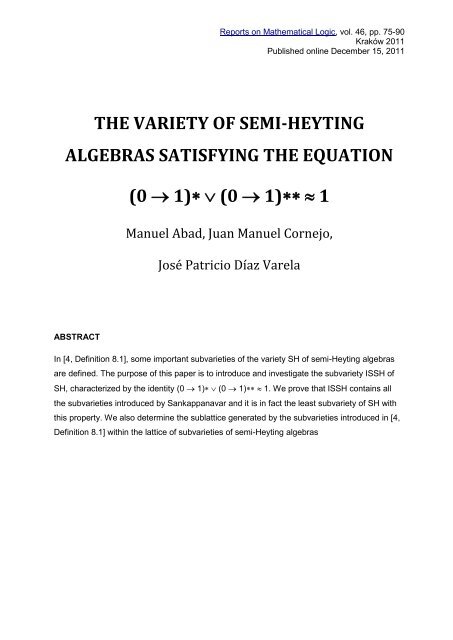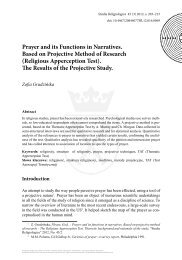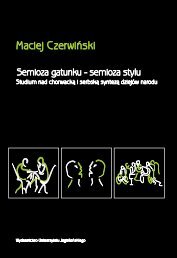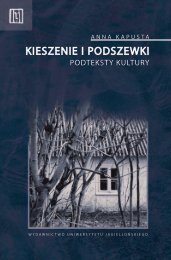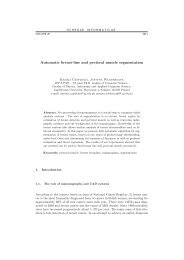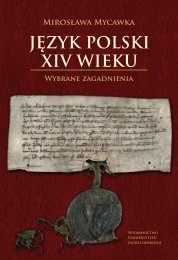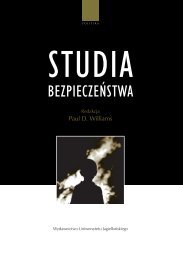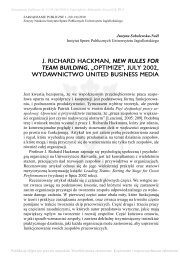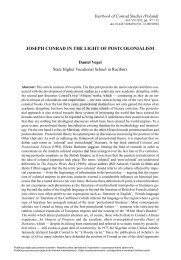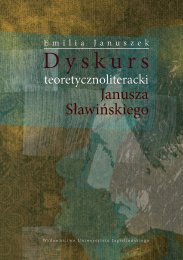the variety of semi-heyting algebras satisfying the equation (0 â 1)
the variety of semi-heyting algebras satisfying the equation (0 â 1)
the variety of semi-heyting algebras satisfying the equation (0 â 1)
You also want an ePaper? Increase the reach of your titles
YUMPU automatically turns print PDFs into web optimized ePapers that Google loves.
Reports on Ma<strong>the</strong>matical Logic, vol. 46, pp. 75-90<br />
Kraków 2011<br />
Published online December 15, 2011<br />
THE VARIETY OF SEMI-HEYTING<br />
ALGEBRAS SATISFYING THE EQUATION<br />
(0 1) (0 1) 1<br />
Manuel Abad, Juan Manuel Cornejo,<br />
José Patricio Díaz Varela<br />
ABSTRACT<br />
In [4, Definition 8.1], some important subvarieties <strong>of</strong> <strong>the</strong> <strong>variety</strong> SH <strong>of</strong> <strong>semi</strong>-Heyting <strong>algebras</strong><br />
are defined. The purpose <strong>of</strong> this paper is to introduce and investigate <strong>the</strong> sub<strong>variety</strong> ISSH <strong>of</strong><br />
SH, characterized by <strong>the</strong> identity (0 1) (0 1) 1. We prove that ISSH contains all<br />
<strong>the</strong> subvarieties introduced by Sankappanavar and it is in fact <strong>the</strong> least sub<strong>variety</strong> <strong>of</strong> SH with<br />
this property. We also determine <strong>the</strong> sublattice generated by <strong>the</strong> subvarieties introduced in [4,<br />
Definition 8.1] within <strong>the</strong> lattice <strong>of</strong> subvarieties <strong>of</strong> <strong>semi</strong>-Heyting <strong>algebras</strong>
REPORTS ON MATHEMATICAL LOGIC<br />
46 (2011), 75–90<br />
Manuel ABAD, Juan Manuel CORNEJO 1<br />
and José Patricio DÍAZ VARELA2<br />
THE VARIETY OF SEMI-HEYTING<br />
ALGEBRAS SATISFYING THE EQUATION<br />
(0 → 1) ∗ ∨ (0 → 1) ∗∗ ≈ 1<br />
A b s t r a c t. In [4, Definition 8.1], some important subvarieties <strong>of</strong><br />
<strong>the</strong> <strong>variety</strong> SH <strong>of</strong> <strong>semi</strong>-Heyting <strong>algebras</strong> are defined. The purpose<br />
<strong>of</strong> this paper is to introduce and investigate <strong>the</strong> sub<strong>variety</strong> ISSH<br />
<strong>of</strong> SH, characterized by <strong>the</strong> identity (0 → 1) ∗ ∨ (0 → 1) ∗∗ ≈ 1.<br />
We prove that ISSH contains all <strong>the</strong> subvarieties introduced by<br />
Sankappanavar and it is in fact <strong>the</strong> least sub<strong>variety</strong> <strong>of</strong> SH with<br />
this property. We also determine <strong>the</strong> sublattice generated by <strong>the</strong><br />
subvarieties introduced in [4, Definition 8.1] within <strong>the</strong> lattice <strong>of</strong><br />
subvarieties <strong>of</strong> <strong>semi</strong>-Heyting <strong>algebras</strong>.<br />
1 I wish to dedicate this work to my fa<strong>the</strong>r Francisco Cornejo.<br />
2 The support <strong>of</strong> CONICET is grateful acknowledged<br />
Received 10 September 2009<br />
Publikacja objęta jest prawem autorskim. Wszelkie prawa zastrzeżone. Kopiowanie i rozpowszechnianie zabronione
76 MANUEL ABAD, JUAN MANUEL CORNEJO AND JOSÉ PATRICIO DÍAZ VARELA<br />
1.<br />
Introduction and preliminaries<br />
In [4], Sankappanavar introduced a new <strong>equation</strong>al class SH <strong>of</strong> <strong>algebras</strong>,<br />
which he called “Semi-Heyting Algebras”, as an abstraction <strong>of</strong> Heyting <strong>algebras</strong>.<br />
This <strong>variety</strong> includes Heyting <strong>algebras</strong> and share with <strong>the</strong>m some<br />
ra<strong>the</strong>r strong properties. For example, <strong>the</strong> <strong>variety</strong> <strong>of</strong> <strong>semi</strong>-Heyting <strong>algebras</strong><br />
is arithmetical, <strong>semi</strong>-Heyting <strong>algebras</strong> are pseudocomplemented distributive<br />
lattices and <strong>the</strong>ir congruences are determined by filters. Sankappanavar<br />
introduced in his work several subvarieties <strong>of</strong> SH, for instance, <strong>the</strong><br />
<strong>variety</strong> SH S <strong>of</strong> Stone <strong>semi</strong>-Heyting <strong>algebras</strong>, <strong>the</strong> <strong>variety</strong> SH B <strong>of</strong> Boolean<br />
<strong>semi</strong>-Heyting <strong>algebras</strong>, <strong>the</strong> <strong>variety</strong> QH <strong>of</strong> quasi-Heyting <strong>algebras</strong>, <strong>the</strong> <strong>variety</strong><br />
SH C generated by <strong>semi</strong>-Heyting chains, investigated in [1], <strong>the</strong> <strong>variety</strong><br />
FT T in which 0 → 1 ≈ 1, <strong>the</strong> <strong>variety</strong> FT F in which 0 → 1 ≈ 0, and<br />
so on. These new varieties seem to be <strong>of</strong> interest from <strong>the</strong> point <strong>of</strong> view<br />
<strong>of</strong> non-classical logic, since <strong>the</strong>y can provide a new interpretation for <strong>the</strong><br />
implication connective.<br />
The purpose <strong>of</strong> this paper is to introduce and investigate <strong>the</strong> sub<strong>variety</strong><br />
ISSH <strong>of</strong> <strong>semi</strong>-Heyting <strong>algebras</strong> <strong>satisfying</strong> <strong>the</strong> <strong>equation</strong> (0 → 1) ∗ ∨ (0 →<br />
1) ∗∗ ≈ 1. Clearly, <strong>the</strong> <strong>variety</strong> <strong>of</strong> Stone <strong>semi</strong>-Heyting <strong>algebras</strong> is contained<br />
in ISSH. Moreover, ISSH contains all <strong>the</strong> subvarieties introduced in [4],<br />
and it is in fact <strong>the</strong> least sub<strong>variety</strong> <strong>of</strong> SH that contains all <strong>the</strong> subvarieties<br />
<strong>of</strong> Sankappanavar.<br />
We start by recalling some definitions and basic results ([2], [3] and [4]).<br />
A <strong>semi</strong>-Heyting algebra is an algebra L = 〈L, ∨, ∧, →, 0, 1〉 such that<br />
(SH1) 〈L, ∨, ∧, 0, 1〉 is a lattice with 0 and 1,<br />
(SH2) x ∧ (x → y) ≈ x ∧y,<br />
(SH3) x ∧ (y → z) ≈ x ∧ [(x ∧y) → (x ∧z)],<br />
(SH4) x → x ≈ 1.<br />
Semi-Heyting <strong>algebras</strong> are pseudocomplemented distributive lattices,<br />
with <strong>the</strong> pseudocomplement given by x ∗ = x → 0 (see [4]). Never<strong>the</strong>less,<br />
<strong>the</strong> operation → on <strong>semi</strong>-Heyting <strong>algebras</strong> does not enjoy several nice properties<br />
<strong>of</strong> <strong>the</strong> implication on Heyting <strong>algebras</strong> or even on BCK-<strong>algebras</strong>. For<br />
Publikacja objęta jest prawem autorskim. Wszelkie prawa zastrzeżone. Kopiowanie i rozpowszechnianie zabronione


